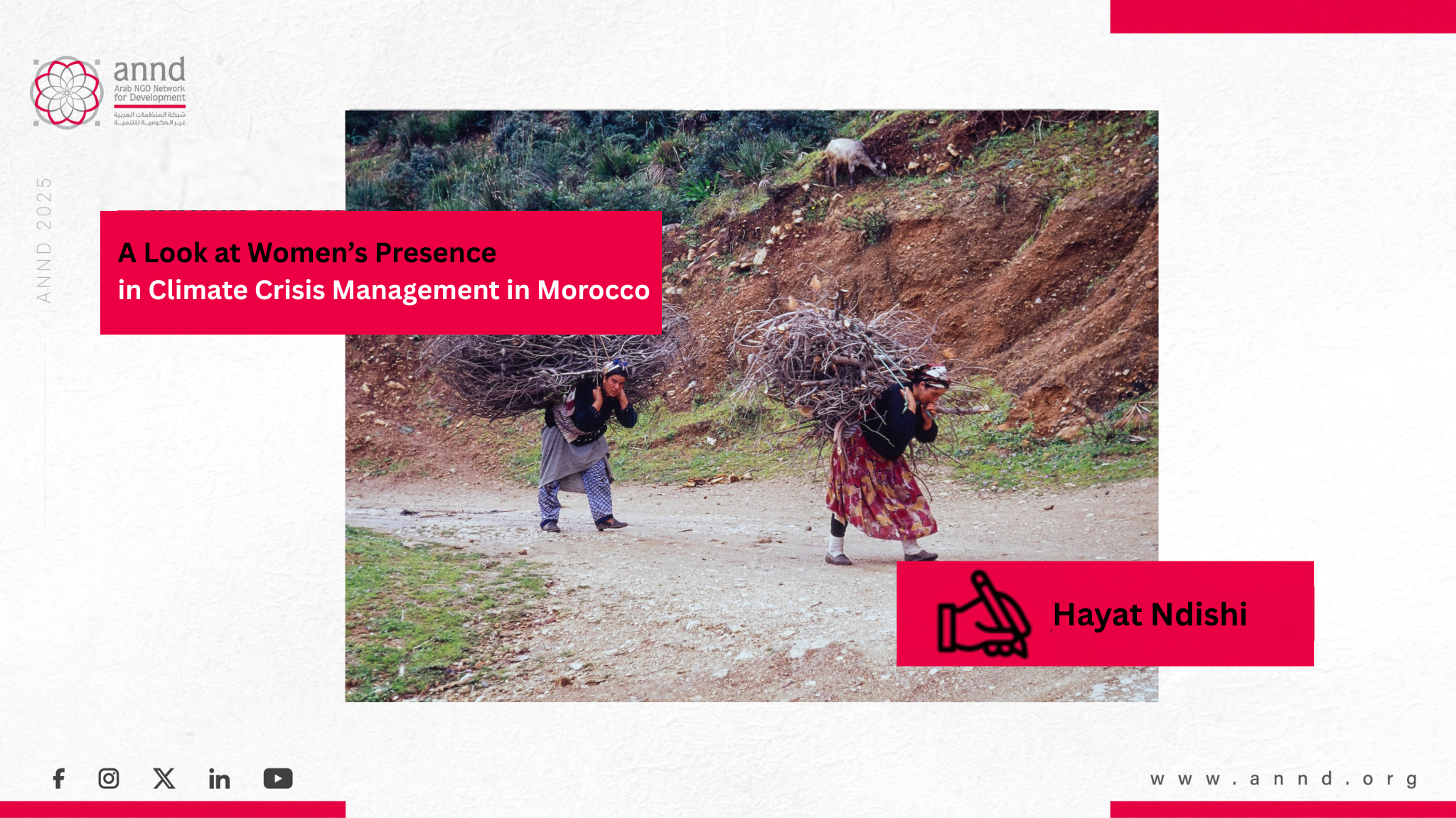
A Look at Women’s Presence in Climate Crisis Management in Morocco – Hayat Ndishi

A Look at Women’s Presence in Climate Crisis Management in Morocco – Hayat Ndishi
Morocco is experiencing a severe climate crisis, having recorded a significant 20% decline in rainfall over the past three decades. This has affected agricultural resources, caused a notable drop in both groundwater and surface water levels, and increased pressure on available water resources. In 2022, Morocco’s per capita water share was about 600 cubic meters annually. The World Bank indicates that annual per capita consumption in Morocco will reach 500 cubic meters in 2024, not far from global trends, while the global standard to avoid water stress is 1,000 cubic meters per person per year. These alarming figures have pushed the Moroccan state to confront these challenges with several strategies, which have mostly fallen short of ensuring food and water security for individuals—especially women and girls.
Climate change in recent decades has become a global concern due to its serious threat to ecosystems and the foundations of sustainable development, negatively affecting efforts to combat fragility and poverty. Returning to the Intergovernmental Panel on Climate Change’s Sixth Assessment Report, it warns that rising temperatures, recurring droughts, and climate disruptions will lead to a decline in agricultural production by up to 30% in some African regions. This impacts the livelihoods and food security of millions of people, including women who are considered environmentally friendly actors. The report Climate Change: Women and the Environment (2020) indicated that women, based on daily lifestyle patterns, contribute less to greenhouse gas emissions than men.
This is linked to factors such as women’s greater use of public transportation, lower spending on cars and air travel, and reduced consumption of energy-intensive goods. These differences do not mean that women inherently possess better environmental qualities, but they reflect the influence of social and economic roles on individual behavior, highlighting the importance of considering these differences when designing environmental policies to ensure justice in climate response.
Similarly, the Sustainable Development Agenda—particularly Goals 1 (No Poverty), 2 (Zero Hunger), and 6 (Clean Water and Sanitation)—emphasized the need to integrate a gender perspective into climate and environmental policies, recognizing that climate change disproportionately affects women and girls.
Discussing food and water security in Morocco requires clarifying their definitions. According to the 1996 World Food Summit, food security exists when all people, at all times, have physical and economic access to sufficient, safe, and nutritious food that meets their dietary needs and preferences for an active and healthy life. Water security means ensuring the availability of water in sufficient quality and quantity to meet human, animal, agricultural, and industrial needs, while guaranteeing its sustainability for future generations. When linked to gender, these concepts refer to women’s and girls’ equitable access to food and water resources, decision-making power, and sustainable benefit without discrimination based on sex.
Analyzing these concepts shows that global warming and environmental imbalance make access and decision-making authority in managing water and food resources complex—especially for women and girls. Despite efforts to confront environmental and climate challenges through major national strategies, their impact has remained limited across different groups, particularly regarding food and water security.
Among these strategies is the Green Morocco Plan, which, despite its positive role in modernizing the sector, concentrated support heavily on export-oriented crops, increasing the marginalization of small farmers—most of whom are women—by limiting their access to investment opportunities and land ownership. The Green Generation Strategy made significant progress in targeting rural women, placing them at its core by facilitating access to cooperative financing and encouraging environmentally friendly, climate-resilient women-led agricultural enterprises. However, it has still not succeeded in improving women’s access to land ownership nor in closing the gender gap concerning food security.
In terms of water security, Morocco has taken important steps to confront water access challenges, including the National Water Strategy 2030. While it contributed to improving access to drinking water, it did not succeed in balancing urban and rural areas, with the latter remaining more vulnerable to climate fluctuations and declining resources.
Multiple policies and plans have attempted to integrate climate justice for women into their strategic vision, yet they have struggled to establish a comprehensive approach that considers spatial disparities—between men and women and among women themselves (young, elderly, migrants, women with disabilities, single mothers, oasis women, mountain women, etc.). The limited impact in ensuring women’s food and water security is due to several factors, notably the lack of coordination among public and territorial policies related to women’s empowerment and persistent inequality in economic ownership—including water and land, whether private or state-managed collectively. Women also have fewer opportunities to benefit from government agricultural investment support, and credit systems remain unsuitable for economic disparities, failing to consider women’s circumstances or societal norms that confine them to non-productive roles, resulting in assets being registered under men’s names. Consequently, women remain dependent on subsistence economies tied primarily to rainfall, making them the most affected by drought and water scarcity.
Morocco’s socio-economic structure not only prevents women from benefitting from food ownership through land ownership but also forces them to bear the burden of water collection in areas without piped water networks. This burden has increased due to declining groundwater levels and the drying of many wells and valleys, exposing women to daily hardship, depriving girls of educational success, and denying women the ability to enjoy intimate life with their partners.
These challenges, along with weak health infrastructure in drought-affected regions, negatively impact women’s physical and reproductive health, fertility, and increase the spread of diseases—particularly skin and immune-related illnesses linked to malnutrition and poor hygiene, especially among pregnant and breastfeeding women and adolescent girls. Heatwaves, drought, and water pollution also aggravate women’s psychological stress due to the anxiety of supporting their families under unstable conditions.
The effects of climate change in Morocco extend beyond the environmental dimension to the social structure and gender relations, reinforcing inequalities between men and women—especially in rural and mountain areas. As water scarcity increases and agricultural production declines, job and income opportunities for women shrink, pushing many to depend economically on men or migrate to cities in search of alternative livelihoods, often in vulnerable sectors such as domestic work or the informal economy. This deepens female poverty and reduces women’s economic independence, weakening their decision-making power within families and communities.
The food and water crisis facing Moroccan women also stems from their exclusion from public and territorial decision-making positions and from local committees managing climate and water crises. This has driven some women to participate in protest movements—such as the women’s movement in Figuig—demanding their right to water access, rejecting its privatization, and calling for their involvement in management through inclusive policies that consider women not only as beneficiaries but as key actors in managing natural resources and shaping environmental decision-making.
In conclusion, achieving food and water security for women and confronting climate change requires adopting inclusive gender- and territory-sensitive policies, as well as transformative strategies that go beyond temporary relief to focus on building long-term resilience, in line with the transformative spirit of the Sustainable Development Goals. This includes improving water infrastructure, especially in rural and peri-urban areas; establishing gender-sensitive indicators in national reports on climate and sustainable development; developing women’s knowledge; and strengthening their representation in resource management while considering disasters, crises, and drought seasons within social protection programs.
Food and water security for women is not merely an issue of resources—it is a matter of justice and human rights. Ensuring access to resources and integrating women into decision-making processes is no longer optional; it is essential for achieving equality, social justice, sustainable development, and a more just society.

